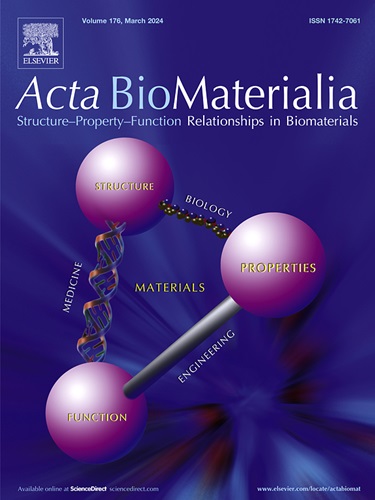Matrix metalloproteinase-responsive melanin nanoparticles utilize live neutrophils for targeted high-risk plaque detection and atherosclerosis regression
IF 9.4
1区 医学
Q1 ENGINEERING, BIOMEDICAL
引用次数: 0
Abstract
Abrupt rupture of atherosclerotic plaque is the predominant contributor to acute cardiovascular events. It is of clinical importance to effectively identify and inhibit high-risk plaque progression. However, this remains a major challenge due to the inadequate targeting of theranostic agents to atherosclerotic lesions. Herein, we utilize live neutrophils to encapsulate melanin-based theranostics (termed MNPpep-Gd) to enhance their plaque targeting, leveraging the inherent inflammatory tropism of neutrophils in atherosclerosis progression. The MNPpep-Gd are fabricated using the water-insoluble gadolinium-chelated melanin nanoparticle modified with a detachable polyethylene glycol (PEG) segment via a matrix metalloproteinase (MMP)-cleavable peptide linker. Our work demonstrated that overexpressed MMP in high-risk plaques can induce an increase in particle size and prolonged retention time of the MNPpep-Gd nanoprobe in lesions, making it a highly efficient contrast agent for magnetic resonance (MR) and photoacoustic (PA) dual-modal imaging atherosclerotic plaque. Concurrently, the melanin nanoparticles function as a therapeutic agent by scavenging multiple toxic reactive oxygen species (ROS), inhibiting the pro-inflammatory cytokines expression, and significantly reducing the foam cell formation. As a result, NE/MNPpep remarkably alleviates atherosclerosis progression by a 24.7 % reduction for plaque area in ApoE−/− mice. Immunohistochemical analysis confirmed that NE/MNPpep treatment significantly reduced the macrophage content by 21.3 % and lipid burden by 15.6 % in plaques. In conclusion, our innovative nanoagent actively targets atherosclerotic sites, offers a noninvasive approach for identifying high-risk atherosclerotic plaques, and significantly contributes to the alleviation of lesion development in ApoE−/− mice.
Statement of significance
Effective identification and inhibition of high-risk plaque progression hold clinical importance. However, it remains a major challenge due to the insufficient targeting of theranostic agents to plaques. Herein, a biomimetic nanoplatform is developed to actively target atherosclerosis plaque with the assistance of neutrophils, thereby minimizing off-target effects. Then, overexpressed MMP2 in high-risk plaques trigger the aggregation of hydrophobic Gd3+-labeled melanin nanoparticles, enhancing both MRI/PAI intensities for precise diagnosis. Additionally, the native antioxidant activity of melanin reduces inflammatory level, alleviates oxidative damage, and inhibits plaque progression in ApoE−/− mice. This study offers valuable insights for accurate plaque assessment and provides effective guidance for subsequent management strategies.

求助全文
约1分钟内获得全文
求助全文
来源期刊

Acta Biomaterialia
工程技术-材料科学:生物材料
CiteScore
16.80
自引率
3.10%
发文量
776
审稿时长
30 days
期刊介绍:
Acta Biomaterialia is a monthly peer-reviewed scientific journal published by Elsevier. The journal was established in January 2005. The editor-in-chief is W.R. Wagner (University of Pittsburgh). The journal covers research in biomaterials science, including the interrelationship of biomaterial structure and function from macroscale to nanoscale. Topical coverage includes biomedical and biocompatible materials.
 求助内容:
求助内容: 应助结果提醒方式:
应助结果提醒方式:


